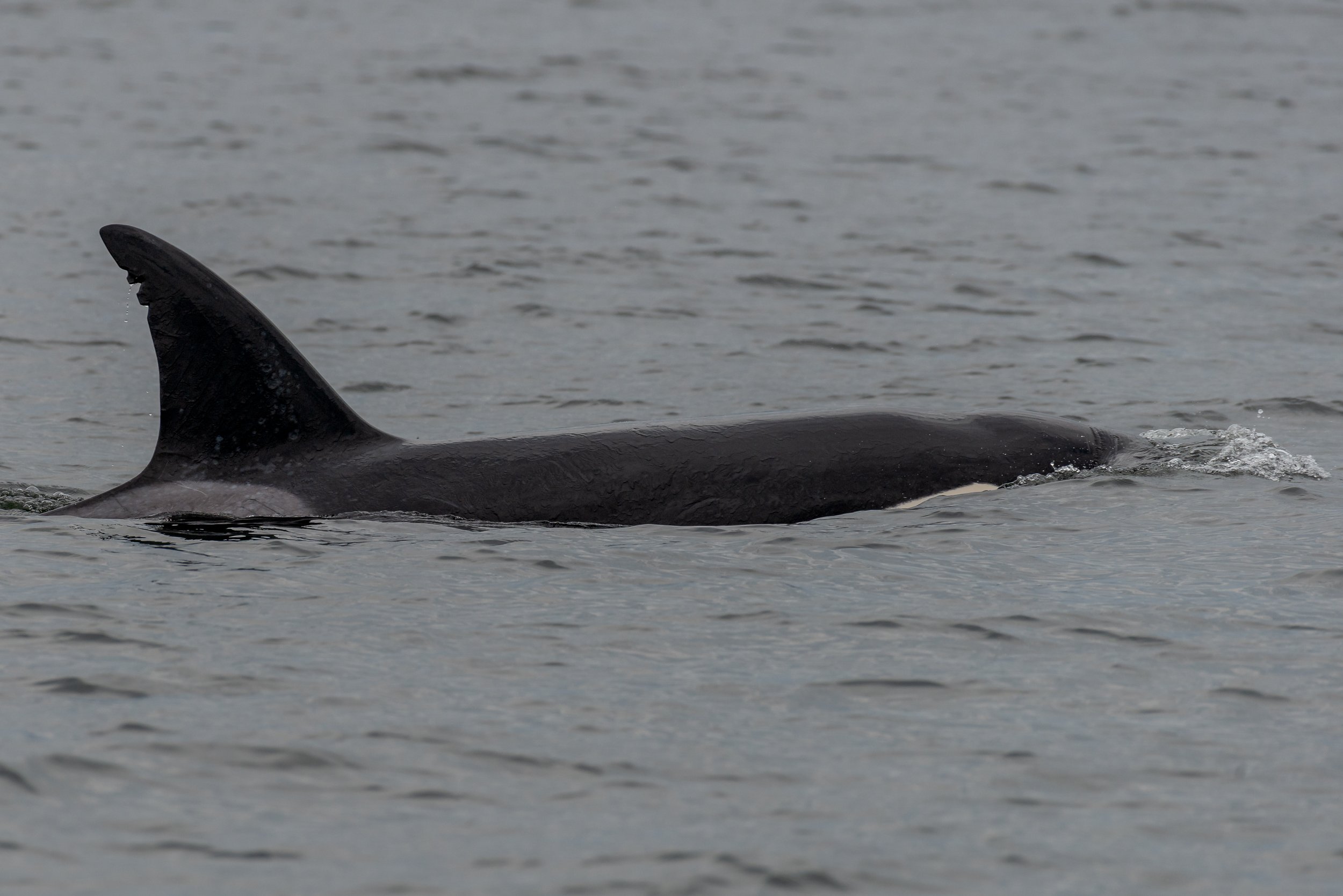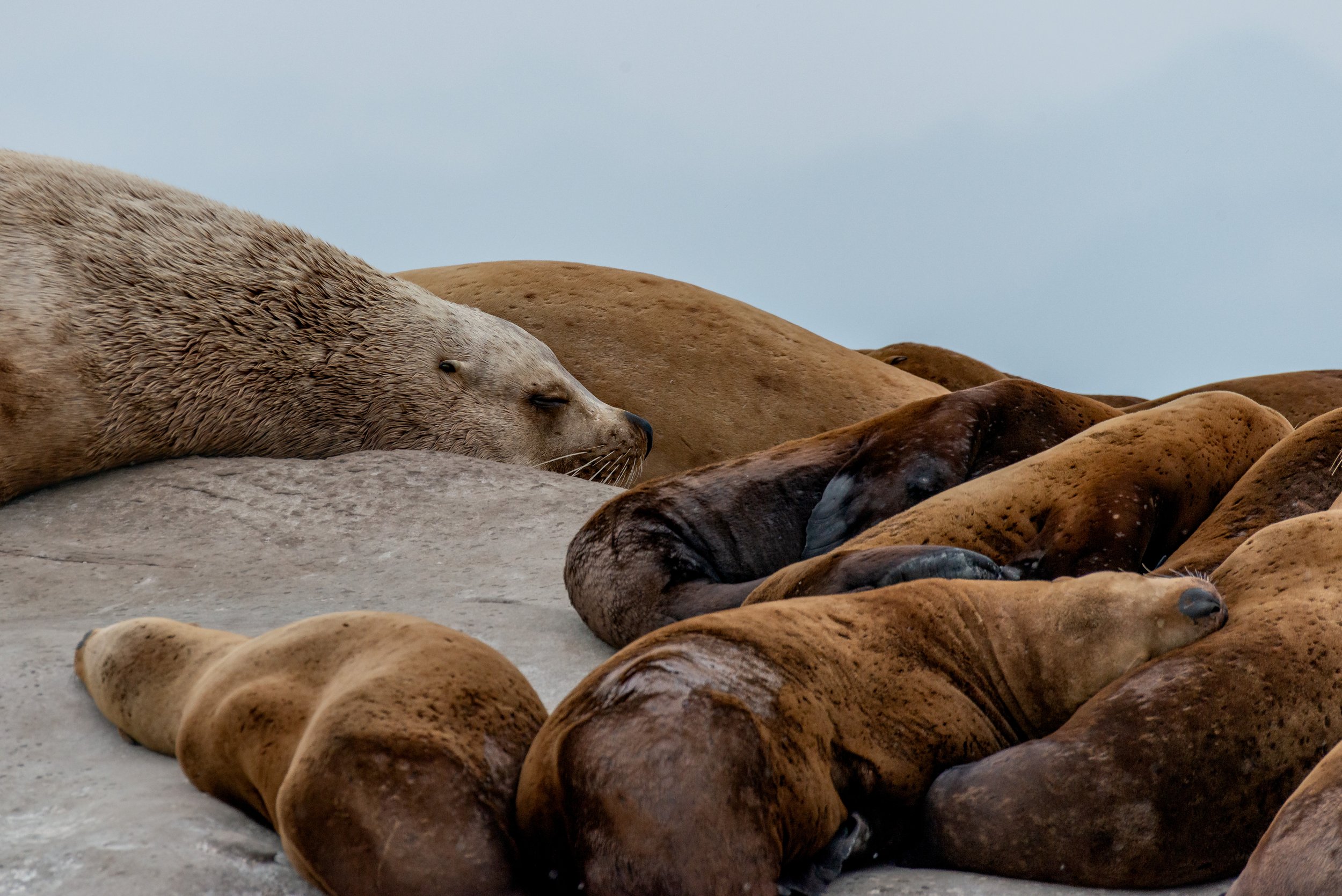June 9, 2023 10:30 - T046Cs in Trincomali
Both of our open zodiacs and our semi-covered vessel were out on this Friday morning. The day began with harbour seals and sea lions within the Strait of Georgia, followed by meeting up with a pod of orca in Trincomali Channel within the Gulf Islands, near the mouth of Porlier Pass.
Orcas that we saw on this morning’s tour include:
T046C Carmanah ♀ (1994)
T046C1 Tsunami ♂ (2006)
T046C3 Razor (2013)
T046C4 Hobi (2018)
As far as we know, the T046Cs are a new pod sighting for us, with their more common areas of travel being on the west coast of Vancouver Island or off of Haida Gwaii. T046C Carmanah, the matriarch of the T046Cs, is a relatively young matriarch at 29 years old. Female transient orca can live up to 90 years old, though similarly to humans their reproductive state comes to a halt when they’re about 45-50 years old. After menopause, they remain the wise matriarch, known for their vast knowledge of years of hunting and teaching their offspring the pod’s unique dialect. It’s only known that three species go through menopause: orcas, humans and short-finned pilot whales. Carmanah was followed by three of her children this day: T046C1 Tsunami, T046C3 Razor and T046C4 Hobi. Carmanah has four children, but T046C2 Sam tends to travel by themself or with other family pods.
T046C1 Tsunami is at the age where his dorsal fin is almost fully grown! Male orcas start going through their “puberty” at about 12-15 years old, in which their dorsal fin starts to sprout and will reach it’s full height by 20-25 years old. At their maximum height, male dorsal fins measure up to 6 feet tall or 1.8 metres, whereas female orcas dorsal fins reach up to about 2.5 feet or 0.8 metres in height. Male orcas don’t live quite as long as females, but they can reach over 70 years in age. Typically, male orcas will stay with their mom for their whole lives. The time for mating occurs when different family pods join together in what is known as a T-party, where hunting and playing with one another is also known to occur.
Both harbour seals and sea lions at Stinky Rock were spotted this morning. The main differences between seals and sea lions are in their ears and tails fins. Harbour seals don’t have ears, but instead have holes in the side of the head, with no tissue making an ear structure, whereas sea lions do have external ear flaps. Seals and sea lions are both part of the clade Pinnipedia. Pinnipeds have great hearing and eyesight, seeing up to 200 metres away below water. Hearing of pinnipeds such as walrus, seals and sea lions can only be described as having multi-mechanism hearing. Depending on the medium they are in, they will either use typical middle-ear air filled cavities to hear on land or an entirely bone-conducted hearing mechanism while they are in the water.
The Gabriola Bluffs were the last stop of the day for a view of the sandstone and cormorants on the cliffside. Two different species of cormorant reside on the bluffs: the Pelagic Cormorants and Double-Crested Cormorants. The Pelagic Cormorants have a very shiny iridescent black feather, appearing green/purple in the right lighting, whereas the Double-Crested Cormorants have a slightly bigger and more orange beak than the Pelagic Cormorants and matte black feathers that appear brown in juveniles. The cormorants continue to nest at the Gabriola Bluffs and return there year after year while spending their winters in Mexico. At this time of the year, they are very busy collecting nesting material and laying their eggs, which hatch 21-25 days after they have been laid.
Photos today were taken by Marine Naturalists Vanessa Vereschahen, Des Poier and Aly Kohlman.
T046C1 Tsunami and T046C3 Razor. Photo by Vanessa Vereschahen.
T046C1 Tsunami. Photo by Aly Kohlman.
T046C Carmanah. Photo by Aly Kohlman.
T046C1 Tsunami. Photo by Aly Kohlman.
T046C1 Tsunami (left) and T046C3 Razor (right). Photo by Aly Kohlman.
T046C1 Tsunami (left) and T046C3 Razor (right). Photo by Aly Kohlman.
T046C1 Tsunami. Photo by Aly Kohlman.
T046C3 Razor and T046C1 Tsunami. Photo by Aly Kohlman.
T046C3 Razor. Photo by Aly Kohlman.
T046C Carmanah. Photo by Aly Kohlman.
T046C4 Hobi. Photo by Aly Kohlman.
T046C1 Tsunami. Photo by Aly Kohlman.
T046C3 Razor. Photo by Aly Kohlman.
Harbour porpoise. Photo by Aly Kohlman.
Sleepy Harbour seals. Photo by Aly Kohlman.
Photo by Vanessa Vereschahen.
Photo by Vanessa Vereschahen.
Photo by Aly Kohlman.
Photo by Aly Kohlman.
Photo by Aly Kohlman.
Photo by Aly Kohlman.
Photo by Vanessa Vereschahen.
Photo by Vanessa Vereschahen.
Photo by Vanessa Vereschahen.
Photo by Vanessa Vereschahen.
Photo by Vanessa Vereschahen.
An Eagle with a snack. Photo by Vanessa Vereschahen.
Photo by Vanessa Vereschahen.
Eaglet in the nest. Photo by Aly Kohlman.
A curious young eagle. Photo by Vanessa Vereschahen.
Looking along the Gabriola shoreline, looking out into Rainbow Channel. Photo by Vanessa Vereschahen.
Photo by Vanessa Vereschahen.
Cormorants. Photo by Vanessa Vereschahen.
Photo by Vanessa Vereschahen.
Photo by Vanessa Vereschahen.
Photo by Vanessa Vereschahen.




































